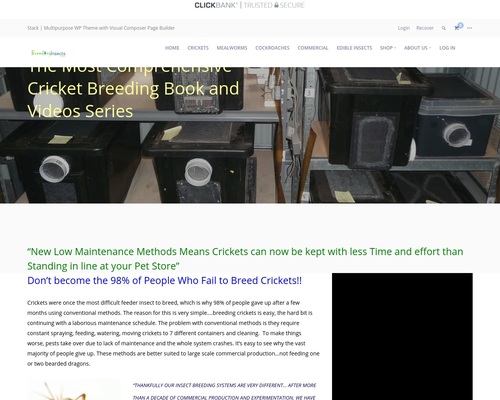![]() 2 breeding systems to choose from to ensure the best method for all types of breeding. (i.e. small, medium and large scale/commercial production).
2 breeding systems to choose from to ensure the best method for all types of breeding. (i.e. small, medium and large scale/commercial production).
![]() 26 pages detailing advantages/disadvantages for different systems, building material, and step by step instructions how to construct breeding systems.
26 pages detailing advantages/disadvantages for different systems, building material, and step by step instructions how to construct breeding systems.
![]() See above sections (Why our systems work so well) for details how our breeding systems produce twice the crickets with half the effort.
See above sections (Why our systems work so well) for details how our breeding systems produce twice the crickets with half the effort.
![]() Learn the essential management secrets which ensures productive and consistent breeding.
Learn the essential management secrets which ensures productive and consistent breeding.
Private and Small Scale Commercial breeding
9.0 Zega Substrate Breeding System (Small Scale Production)
9.1 Summary of Breeding Method………………………………………….. 118
9.2 How to Make a Zega Substrate Breeding System………………….. 120
9.3 Management of a Substrate System…………………………………… 128
9.4 Cleaning a Substrate System……………………………………………. 129
9.5 Maintenance of a Substrate System…………………………………… 131
Batch Breeding System (Large Scale Production)
10.1 Summary of Breeding Method………………………………………….. 135
10.2 How to Make a Batch System…………………………………………… 137
10.3 Food and Water Dispenser for a Pinhead Grow Out Container……. 147
10.4 Management of a Batch System……………………………………….. 151
10.5 Pests for a Batch System…………………………………………………. 152
10.6 Cleaning a Batch System………………………………………………… 156
10.7 Maintenance of a Batch System……………………………………….. 158
Container Design and Construction
![]() Learn the 5 essential design considerations for an efficient container which is durable, maximizes growth rates, and saves time in maintenance and feeding activities.
Learn the 5 essential design considerations for an efficient container which is durable, maximizes growth rates, and saves time in maintenance and feeding activities.
![]() Some of the items covered includes how to maximize ventilation and air flow, easy access ports for feeding and removing crickets, removable screens for increased ventilation/heat management, keeping pinheads in and pest out.
Some of the items covered includes how to maximize ventilation and air flow, easy access ports for feeding and removing crickets, removable screens for increased ventilation/heat management, keeping pinheads in and pest out.
![]() Detailed instructions and photos showing how to build step by step.
Detailed instructions and photos showing how to build step by step.
3.1 Choosing a Container……………………………………………………………. 23
3.2 Lids…………………………………………………………………………………24
3.3 Ventilation…………………………………………………………………….. 25
3.4 Feeding Port………………………………………………………………….. 26
3.5 Screening………………………………………………………………………. 26
3.6 Barrier Cream……………………………………………………………….. 27
3.7 Component Set-up……………………………………………………………28
3.8 How to Make a Cricket Container…………………………………………… 29
Heating and Storage

Tables which provide the various temperature thresholds to manage a cricket colony
![]()
Advantages/disadvantages for 4 different heating systems including free solar options. Find out the best method for productive cricket production.
![]() Learn the thermodynamic principles for efficient heat conservation.
Learn the thermodynamic principles for efficient heat conservation.
![]() 20 methods to reduce your heating costs.
20 methods to reduce your heating costs.
![]() How to estimate your heating costs and manage excessive heat.
How to estimate your heating costs and manage excessive heat.
![]() How to store breeding containers so they are easy to access and feeding can be done without opening the lid. This will allow numerous containers can be stored into a tight configuration, to save space or to increase the number of containers.
How to store breeding containers so they are easy to access and feeding can be done without opening the lid. This will allow numerous containers can be stored into a tight configuration, to save space or to increase the number of containers.
6.1 Heating…………………………………………………………………………. 75
6.2 Humidity……………………………………………………………………… 76
6.3 Heating Systems……………………………………………………………. 77
6.4 Reducing Heating Costs…………………………………………………. 80
6.5 Estimating Heating Costs………………………………………………. 82
6.6 Managing Excessive Heat……………………………………………….83
6.7 Storage of Colony………………………………………………………….. 83
Maintenance

![]() Our innovative breeding systems prevent detritus from coming into contact with wet substrate, preventing fouling (eliminates smells) and cutting maintenance frequency by half.
Our innovative breeding systems prevent detritus from coming into contact with wet substrate, preventing fouling (eliminates smells) and cutting maintenance frequency by half.
![]() 3 different cleaning systems reduces maintenance to only a few minutes for each breeding container.
3 different cleaning systems reduces maintenance to only a few minutes for each breeding container.
7.2 Pests……………………………………………………………………………. 91
7.3 Genetics………………………………………………………………………. 95
7.4 Safety………………………………………………………………………….. 96
Pest Management
![]() Detailed information on how to manage all major pests, which often result in the failure of consistent cricket breeding.
Detailed information on how to manage all major pests, which often result in the failure of consistent cricket breeding.
Our clever container design prevents pests from entering, including a special double screen system to keep out micro flies, a major pest species.
![]() Details how to build ant exclusion devices and micro-fly traps to prevent infestations.
Details how to build ant exclusion devices and micro-fly traps to prevent infestations.
![]() How to maintain genetics and maintain productivity
How to maintain genetics and maintain productivity
Grading and Selling

![]() Learn how to quickly separate crickets from their cartons without escapees and with minimal effort.
Learn how to quickly separate crickets from their cartons without escapees and with minimal effort.
8.2 Estimating Cricket numbers…………………………………………….. 102
8.3 Packaging and Transport…………………………………………………. 106
8.4 Economics……………………………………………………………………. 110
8.5 Marketing…………………………………………………………………….. 113
8.6 Record Keeping…………………………………………………………….. 115
Biology

How to choose the best species to for cricket breeding. Advantages and disadvantages between different species.
![]()
Diagrams and photos of the anatomy of a cricket and how to distinguish between female/male, adult and medium crickets.
![]()
Understand the lifecycle, breeding and behaviour characteristics of crickets to reduce cannibalism and increase breeding success.
![]()
Find out the best temperatures to maximise egg viability and cricket growth. The best heating methods to increase productivity.
![]()
The main nutrient and environmental conditions for productive cricket breeding.
List of Tables
Part 1- Choosing a Breeding Method and Introduction
Table 1- Advantages and Disadvantages between Breeding Crickets and Cockroaches………………………………….. 13
Table 2- Conversion between Imperial and Metric Units…………………. 15
Diagram 2.3- Anatomy of a Cricket…………………………………………………… 18
Part 2- General Techniques- For Both Breeding Methods
Table 3- Growth Rates………………………………………………………………… 21
Figure 3.3- Air Flow through a Container………………………………………. 25
Table 4- Design Summary for Constructing a Container
– Efficient Method…………………………………………………………… 30
Table 5- Detailed Instructions Constructing a Container-
Efficient Method………………………………………………………….. 33
Table 6- Nutritional Comparison between Different Dry Food Types……………………………………………………………. 42
Table 7- Making a Food Tray………………………………………………………55
Table 8 How to Make a Small Scale Food Dispenser………………….. 56
Table 9- Making a Large Scale Food Dispenser…………………………… 60
Table 10- Making a Large Scale Water Dispenser…………………………. 65
Table 11- Making a Large Scale Water Dispenser with Pebbles……… 72
Table 12- Temperature Ranges for Crickets……………………………………75
Table 13- Cleaning Food and Water Dispensers…………………………… 85
Table 14- Making an Ant Guard for Power Cords………………………….94
Table 15- Grading Crickets………………………………………………………… 98
Table 16- Counting Crickets- Large Scale …………………………………… 103
Table 17- Transport Methods……………………………………………….. 107
Part 3- Small Scale Cricket Breeding
Figure 9.1- Diagrammatic Representation of a Substrate Breeding System……………………………………. 118
Table 18- How to Make a Substrate System……………………………. 122
Table 19- Removal of Detritus from a Substrate System………………. 129
Table 20- Maintenance Schedule for a Substrate System……………. 132
Part 4- Large Scale Cricket Breeding
Figure 10.1- Diagram of a Batch Breeding System………………………. 136
Table 21- Summary of a Batch Breeding System……………………… 138
Table 22- Detailed Instructions to Make a Batch System………….. 141
Table 23- How to Make Food and Water Dispenser for a Pinhead Grow out Container…………………………………. 147
Table 24- Cleaning a Batch System (No Substrate) …………………. 156
Table 25- Maintenance Schedule for a Batch System………………. 158
Glossary…………………………………………………………………………..161
Appendix 1 Example Marketing Brochure……………………………. 163










